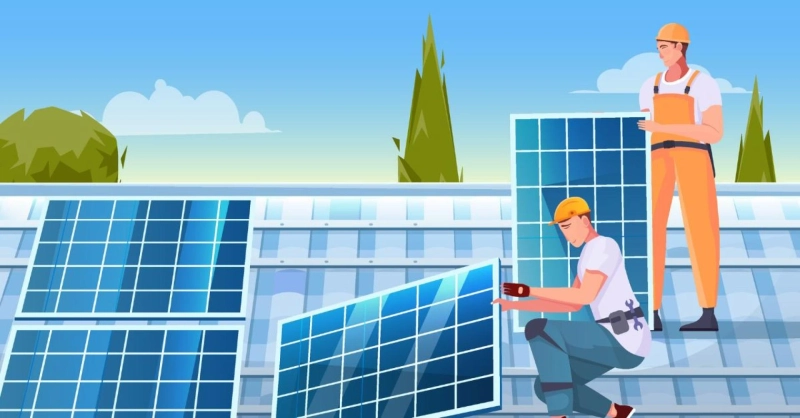During the last two decades, the contribution of solar energy to the world's total energy supply has increased significantly. Energy from the sun is the most abundant and absolutely free energy available on Earth. Solar photovoltaic systems convert solar energy directly into electrical energy. As sunlight strikes a cell in a panel, the cell converts the light into electricity.
The science behind solar cells
To harness solar energy, we need the help of another element found abundantly on Earth's sands. To be used in a solar cell, and needs to be converted into 99.999% pure silicon crystals. To achieve this the sand has to undergo a complex purification.
Sand + carbon → crude silicon
Raw silicon turns into a gaseous silicon compound. It is then combined with hydrogen to obtain very pure silicon. These silicon ingots are then shaped and turned into very thin pieces called silicon wafers. The silicon wafer is the heart of the PV cell.
Solar cell manufacturing
As we know we use semiconductors (silicon) to make solar cells. Here we use two types of silicon semiconductors namely p-type and n-type. An n-type material with a thickness of 0.3 μm was placed on top of the cell and a p-type material with a thickness of 300 μm was placed on the bottom of the cell. N-type material is thinner than p-type material because it can easily enter the cell when sunlight hits it. There is some metal finger on the top of the N-type material. Connecting metal fingers lead to a wire that acts as the negative terminal. Above the metal fingers is a bus bar. Underneath the p-type material is a back contact made of copper through which we pull out the positive wire. Therefore, the solar cell works as a battery. These solar cells are connected in series/parallel and form a solar panel.
Solar panel structure
Solar panels have different layers, and one of them is the cell layer. The upper negative side of the solar cell is connected to the lower positive side of the next solar cell through copper strips. It forms a series of cells When a series of cells are connected in parallel with another series of cells it forms a panel. A single cell is 0.5v. A combination of series-parallel cells increases the voltage and current values to usage limits.
Layers of EVA sheeting on both sides of the cells protect them from shock, vibration, and moisture. There is an anti-reflection coating (tempered glass) that prevents radiation from escaping or heating the cell.
How does this work?
Sunlight falling on Earth is actually bundles of photons or small bundles of energy. Each photon has a finite amount of energy. To generate electricity, photons must be absorbed by solar cells. Photons in sunlight falling on the front of the solar cell are absorbed by the semiconductor material.
P-type materials have few holes and N-type materials have fewer electrons. These electrons are free electrons. When we connect P and N-type materials there is a junction between them called a depletion layer. Since the electrons in the N material are empty, they come through the depletion layer to the P side and fill the holes in the P side. Therefore, there are no free electrons and holes in the depletion layer. Due to electron migration, the n-side boundary becomes slightly positive and the p-side becomes negatively charged.
When light hits the N region of the PV cell it penetrates and reaches the depletion region. This photon energy is sufficient to generate electron-hole pairs in the depletion region. The electric field in the depletion region drives electrons and holes out of the depletion region. The concentration of electrons in the N region and holes in the P region become so high that a potential difference develops between them. As soon as we add any load between these regions, electrons will start flowing through the load. After the electron completes its path, it will reconnect with the holes in the p region.
Thus, a solar cell continuously delivers a direct current. Therefore, a solar cell on which sunlight falls can directly drive DC electrical equipment. But, the amount of electricity generated is proportional to the amount of light incident. Therefore, the amount of electricity generated throughout the day is not constant.
How solar panel efficiency matters in production
A solar cell converts some of the light energy falling on it into electrical energy. Thus, even a PV module converts only a fraction of the total light falling on it into electrical energy. The ratio of the electrical energy produced to the input light energy is called the efficiency of the PV module. The efficiency of the module basically depends on the solar cells used and the method used to interconnect them. In a module, cells can be interconnected in series or parallel connections. Once a module is assembled, its efficiency value is fixed and generally does not change.
The efficiency of a module is given as the maximum power or peak power that the module can produce for a given input of solar radiation. For a given input power pin, the value of the output power is directly determined by the efficiency of the module and the value of the module area. Therefore, a module with higher efficiency values will produce more power because efficiency is directly proportional to maximum power. The output will be higher because the efficiency of the module is higher.


